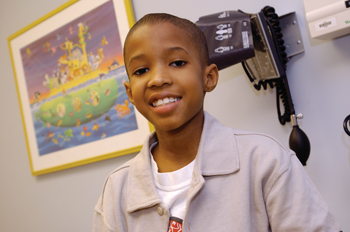
Jamarius House, 10, was the first Vanderbilt patient enrolled in the Pediatric Oncology Experimental Therapeutics Investigation Consortium, or POETIC.
photo by Dana Johnson
Consortium helps keep patients close to home
Whether motivated by hope for a cure or a desire to help others, patients and families who participate in clinical research are a critical piece of the puzzle to improve care for all who are facing cancer.
Now, doctors at Vanderbilt Children's Cancer Program can offer a new avenue of hope and a way to keep these families together and close to home through a new organization of premier cancer centers to conduct the first studies of new therapies in children, called Phase I clinical trials.
The group is called POETIC, which stands for Pediatric Oncology Experimental Therapeutics Investigation Consortium. Its members are Vanderbilt Children's Hospital/Vanderbilt-Ingram Cancer Center, M.D. Anderson Cancer Center, Memorial Sloan-Kettering Cancer Center, the Sidney Kimmel Cancer Center at Johns Hopkins, Children's Healthcare of Atlanta at Egleston, the Children's Hospital at the University of Colorado and the University of Florida.
POETIC has been meeting for the last two-and-a-half years to set up its framework: the goals, mission statements and design for research. This year, its first clinical trial has opened. The first patient enrolled in a POETIC phase I trial here at Vanderbilt was Jamerius House, 10, who has neuroblastoma.
“The benefit of POETIC for patients like Jamerius is that he can participate in these important studies here at home,” said James A. Whitlock, M.D., Craig-Weaver Professor of Pediatrics and director of Pediatric Hematology/Oncology at Vanderbilt.
House is well known to staff at the Monroe Carell Jr. Children's Hospital at Vanderbilt. He shows up for treatments dressed in hip outfits and is always accompanied by two or three family members. His mother, grandmother and uncle all know the nurses and doctors well. For several weeks as part of the first POETIC study at Vanderbilt, House took a drug called 17-AAG.
“We were out of options,” said Donnie Franklin, House's uncle. “He didn't want to go and have surgeries, and we let him decide how he wants to live his life, and going to someplace far away would mean separating the family, and Jamerius didn't want to do that.”
The drug has the effect of suppressing an important protective molecule for cancer cells called Hsp90. Hsp90 helps all cells avoid heat shock and other forms of damage, and it has been found to be especially protective to cancer cells. 17-AAG successfully disarmed the protective powers of Hsp90 in adult cancer trials, leading to better control of some adult cancers, but doctors do not yet know if it will do the same for children.
The goal of Phase I cancer drug studies is to test the safety of a drug at varying doses and to learn how the drug interacts with the body and with the cancer. Drugs that go on to Phase II testing are examined for effectiveness in controlling or eliminating disease.
House is finished getting infusions of 17-AAG, but comes back regularly for checkups, family members in tow. Despite treatments, the tumor that started in a kidney continues to grow and has spread to other parts of his body.
The outcome of the 17-AAG test is known already, at least for House and his family. They know the cancer was not stopped by 17-AAG, but the family hopes another drug might come along that he could try. They have not lost hope that the cancer can at least be slowed, if not cured.
“It was a long shot,” House's uncle said. “Everything doesn't work for everybody, but we had to try. We'd be happy to do it again”
“We thought it was important to offer these families something here. And there are more than enough of these studies to go around,” said Whitlock. “Right now it takes too long for promising drugs to be made available to children. There can be a lag time of several years before a drug that is approved for adults with cancer is even tested in children. We want to develop protocols to test promising new therapies in children once they have reached the Phase II testing level in adults. That would speed the process of finding useful therapies for children quite a bit.”













